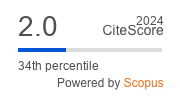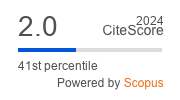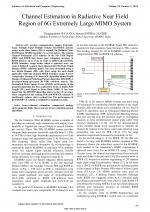| 3/2024 - 7 | View TOC | « Previous Article | Next Article » |
Channel Estimation in Radiative Near Field Region of 6G Extremely Large MIMO SystemSUGANYA, T. |
| Extra paper information in |
| Click to see author's profile in |
| Download PDF |
Author keywords
channel estimation, compressed sensing, electromagnetic fields, linear antenna arrays, matching pursuit algorithms
References keywords
communications(16), mimo(14), estimation(13), channel(13), systems(10), communication(7), wave(6), terahertz(6), massive(6), large(6)
Blue keywords are present in both the references section and the paper title.
About this article
Date of Publication: 2024-08-31
Volume 24, Issue 3, Year 2024, On page(s): 69 - 76
ISSN: 1582-7445, e-ISSN: 1844-7600
Digital Object Identifier: 10.4316/AECE.2024.03007
Web of Science Accession Number: 001306111400007
SCOPUS ID: 85203007503
Abstract
6G wireless communication employ Extremely Large Multiple Input Multiple Output (ELMIMO) antenna arrays at the Base Station (BS) to expand the Radiative Near Field Region (RNFR) boundary by several meters. The existing Channel Estimation (CE) schemes in the Far Field Region (FFR) and RNFR had shown poor estimation accuracy at RNFR distance up to 1 km. In order to address this problem, RNFR boundary range within which a spherical wave can exists is deduced. A sparse three-dimensional (3D) Polar Depth Domain (PDD) codebook matrix has been developed using a new Depth Domain (DD) with finite range for each depth applicable within the obtained RNFR boundary range. A novel Compressive Sensing (CS) based CE algorithm named Depth Domain Orthogonal Matching Pursuit algorithm (DDOMP) is developed using generated 3D PDD codebook matrix. The Normalized Mean Square Error (NMSE) performance of the proposed algorithm has been analyzed in terms of depth, Pilot Length (PL), and Signal to Noise Ratio (SNR). It has been found that the DDOMP algorithm improves the CE accuracy when compared to the existing FFR and NFR CE schemes. It significantly reduces pilot overhead too. The performance of the DDOMP CE scheme is validated by simulation results. |
| References | | | Cited By «-- Click to see who has cited this paper |
| [1] I. F. Akyildiz, J. Jornet, C. Han, "Terahertz band: Next frontier for wireless communications," Physical Communication, vol. 12, no. 4, pp. 16-32, 2014. [CrossRef] [Web of Science Times Cited 1122] [SCOPUS Times Cited 1339] [2] H. Song, T. Nagatsuma, "Present and future of terahertz communications," IEEE Transactions on Terahertz Science and Technology, vol. 1, no. 1, pp. 256-263, 2011. [CrossRef] [Web of Science Times Cited 1050] [SCOPUS Times Cited 1231] [3] W. Jiang, B. Han, M. A. Habibi, H. D. Schotten, "The road towards 6G: A comprehensive survey," IEEE Open Journal of the Communications Society, vol. 2, pp. 334-366, 2021. [CrossRef] [Web of Science Times Cited 848] [SCOPUS Times Cited 1144] [4] H. Elayan, O. Amin, B. Shihada, R. M. Shubair, M.S. Alouini, "Terahertz band: The last piece of RF spectrum puzzle for communication systems," IEEE Open Journal of the Communication Society, vol. 1, pp. 1-32, 2020. [CrossRef] [Web of Science Times Cited 331] [SCOPUS Times Cited 416] [5] Z. Chen, X. Ma, B. Zhang, Y. Zhang, Z. Niu, N. Kuang, W. Chen, L. Li, S. Li, "A survey on terahertz communications," China Communication, vol. 16, no. 2, pp. 1-35, 2019. [CrossRef] [SCOPUS Times Cited 472] [6] W. Yang, M. Li, Q. Liu, "A Practical Channel Estimation Strategy for XL-MIMO Communication Systems," IEEE Communication Letter, vol. 27, no. 6, pp. 1580-1583, 2023. [CrossRef] [Web of Science Times Cited 22] [SCOPUS Times Cited 29] [7] Y. Yuan, C. Wang, C. Li, Z. Zhong, W. Han, C. -X. Wang, "Spatial correlations of measured MIMO channels with an Extremely Large Aperture Array (ELAA)," IEEE 95th Vehicular Technology Conference, pp. 1-5. [CrossRef] [Web of Science Times Cited 4] [SCOPUS Times Cited 4] [8] A. Karstensen et al., "Multiuser spatial consistency analysis of outdoor massive-MIMO measurements," IEEE Transactions on Antennas and Propagation, vol. 70, no. 1, pp. 680-691, 2022. [CrossRef] [Web of Science Times Cited 4] [SCOPUS Times Cited 6] [9] J. Yang, Y. Zeng, S. Jin, C.K. Wen, P. Xu, "Communication and localization with extremely large lens antenna array," IEEE Transactions on Wireless Communications, vol. 20, no. 5, pp. 3031-3048, May 2021. [CrossRef] [Web of Science Times Cited 48] [SCOPUS Times Cited 58] [10] A. Adhikary, J. Nam, J.-Y. Ahn, G. Caire, "Joint spatial division and multiplexing-The large-scale array regime," IEEE Transactions on Information Theory, vol. 59, no. 10, pp. 6441-6463, Oct. 2013. [CrossRef] [Web of Science Times Cited 1034] [SCOPUS Times Cited 1152] [11] J. Lee, G. Gil, Y. H. Lee, "Channel estimation via orthogonal matching pursuit for hybrid MIMO systems in millimeter wave communications," IEEE Transactions on Communications, vol. 64, no. 6, pp. 2370-2386, 2016. [CrossRef] [Web of Science Times Cited 453] [SCOPUS Times Cited 546] [12] Y. Jin, J. Zhang, B. Ai, X. Zhang, "Channel estimation for mmWave massive MIMO with convolutional blind denoising network," IEEE Communications Letters, vol. 24, no. 1, pp. 95-98, 2020. [CrossRef] [Web of Science Times Cited 54] [SCOPUS Times Cited 71] [13] Z. Gao, C. Hu, L. Dai, Z. Wang, "Channel estimation for millimeterwave massive MIMO with hybrid precoding over frequency-selective fading channels," IEEE Communications Letters, vol. 20, pp. 1259-1262, 2016. [CrossRef] [Web of Science Times Cited 262] [SCOPUS Times Cited 299] [14] C. Huang, L. Liu, C. Yuen, S. Sun, "Iterative channel estimation using LSE and sparse message passing for mmWave MIMO systems," in IEEE Transactions on Signal Processing, vol. 67, no. 1, pp. 245-259, 2019. [CrossRef] [Web of Science Times Cited 123] [SCOPUS Times Cited 139] [15] X. Wei, C. Hu, L. Dai, "Deep learning for beamspace channel estimation in millimeter-wave massive MIMO systems," IEEE Transactions on Communications, vol. 69, no. 1, pp. 182-193, 2021. [CrossRef] [Web of Science Times Cited 114] [SCOPUS Times Cited 158] [16] X. Gao, L. Dai, S. Zhou, A. M. Sayeed, L. Hanzo, "Wideband beamspace channel estimation for millimeter-wave MIMO systems relying on lens antenna arrays," IEEE Transactions on Signal Processing, vol. 67, no. 18, pp. 4809-4824, 2019. [CrossRef] [Web of Science Times Cited 92] [SCOPUS Times Cited 113] [17] D. L. Donoho, A. Javanmard, A. Montanari, "Information theoretical optimal compressed sensing via spatial coupling and approximate message passing," IEEE Transactions on Information Theory, vol. 59, no. 11, pp. 7434-7464, 2013. [CrossRef] [Web of Science Times Cited 138] [SCOPUS Times Cited 147] [18] L. Zhao, D. W. K. Ng, J. Yuan, "Multi-user precoding and channel estimation for hybrid millimeter wave systems," IEEE Journal on Selected Areas in Communications, vol. 35, no. 7, pp. 1576-1590, 2017. [CrossRef] [Web of Science Times Cited 186] [SCOPUS Times Cited 219] [19] Y. Chen, L. Yan, C. Han, "Hybrid spherical- and planar-Wave modeling and DCNN-powered estimation of terahertz ultra-massive MIMO channels," IEEE Transactions on Communications, vol. 69, no. 10, pp. 7063-7076, 2021. [CrossRef] [Web of Science Times Cited 47] [SCOPUS Times Cited 55] [20] F. Zhang, W. Fan, "Near-field ultra-wideband mmWave channel characterization using successive cancellation beamspace UCA algorithm," IEEE Transactions on Vehicular Technology, vol. 68, no. 8, pp. 7248-7259, 2019. [CrossRef] [Web of Science Times Cited 28] [SCOPUS Times Cited 31] [21] Y. Han, S. Jin, C. Wen, X. Ma, "Channel estimation for extremely large-scale massive MIMO systems," IEEE Wireless Communications Letters, vol. 9, no. 5, pp. 633-637, 2020. [CrossRef] [Web of Science Times Cited 155] [SCOPUS Times Cited 195] [22] M. Cui, L. Dai, "Channel estimation for extremely large-scale MIMO: Far-field or near-field," IEEE Transactions on Communications, vol. 70, no. 4, pp. 2663-2677, 2022. [CrossRef] [Web of Science Times Cited 329] [SCOPUS Times Cited 454] [23] M. Cui, L. Dai, "Near-field wideband channel estimation for extremely large-scale MIMO," Science China Information Sciences, vol. 66, no. 7, p. 172303, Jun. 2023. [CrossRef] [Web of Science Times Cited 18] [SCOPUS Times Cited 29] [24] P. Ramezani, E. Bjornson, Fundamentals of 6G Communications and Networking, Chapter 12, pp. 317-349, Springer International Publishing, 2024 [25] D. Cheng, "On the simulation of Fraunhofer radiation patterns in the Fresnel region," IRE Transactions on Antennas and Propagation, vol. 5, no. 4, pp. 399-402, 1957. [CrossRef] [SCOPUS Times Cited 16] [26] E. Bjornson, O. T. Demir, L. Sanguinetti, "A primer on near-field beamforming for arrays and reconfigurable intelligent surfaces," Asilomar Conference on Signals, Systems, and Computers, USA, pages 105-112, 2021. [CrossRef] [SCOPUS Times Cited 143] [27] J. W. Sherman, "Properties of focused apertures in the Fresnel region," IRE Transactions on Antennas and Propagation, vol. 10, no. 4, pp. 399-408, 1962. [CrossRef] [SCOPUS Times Cited 238] [28] J. Rodriguez-Fernandez, N. Gonzalez-Prelcic, K. Venugopal, R. W. Heath, "Frequency-domain compressive channel estimation for frequency-selective hybrid millimeter wave MIMO systems," IEEE Transactions on Wireless Communications, vol. 17, no. 5, pp. 2946-2960, 2018. [CrossRef] [Web of Science Times Cited 220] [SCOPUS Times Cited 265] Web of Science® Citations for all references: 6,682 TCR SCOPUS® Citations for all references: 8,969 TCR Web of Science® Average Citations per reference: 230 ACR SCOPUS® Average Citations per reference: 309 ACR TCR = Total Citations for References / ACR = Average Citations per Reference We introduced in 2010 - for the first time in scientific publishing, the term "References Weight", as a quantitative indication of the quality ... Read more Citations for references updated on 2025-05-29 15:45 in 181 seconds. Note1: Web of Science® is a registered trademark of Clarivate Analytics. Note2: SCOPUS® is a registered trademark of Elsevier B.V. Disclaimer: All queries to the respective databases were made by using the DOI record of every reference (where available). Due to technical problems beyond our control, the information is not always accurate. Please use the CrossRef link to visit the respective publisher site. |
Faculty of Electrical Engineering and Computer Science
Stefan cel Mare University of Suceava, Romania
All rights reserved: Advances in Electrical and Computer Engineering is a registered trademark of the Stefan cel Mare University of Suceava. No part of this publication may be reproduced, stored in a retrieval system, photocopied, recorded or archived, without the written permission from the Editor. When authors submit their papers for publication, they agree that the copyright for their article be transferred to the Faculty of Electrical Engineering and Computer Science, Stefan cel Mare University of Suceava, Romania, if and only if the articles are accepted for publication. The copyright covers the exclusive rights to reproduce and distribute the article, including reprints and translations.
Permission for other use: The copyright owner's consent does not extend to copying for general distribution, for promotion, for creating new works, or for resale. Specific written permission must be obtained from the Editor for such copying. Direct linking to files hosted on this website is strictly prohibited.
Disclaimer: Whilst every effort is made by the publishers and editorial board to see that no inaccurate or misleading data, opinions or statements appear in this journal, they wish to make it clear that all information and opinions formulated in the articles, as well as linguistic accuracy, are the sole responsibility of the author.



